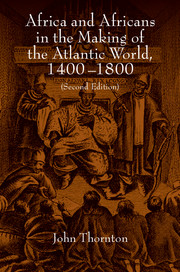Crossref Citations
This Book has been
cited by the following publications. This list is generated based on data provided by Crossref.
Bentley, Jerry H.
1999.
Sea and Ocean Basins as Frameworks of Historical Analysis.
Geographical Review,
Vol. 89,
Issue. 2,
p.
215.
Hancock, David
1999.
The British Atlantic World: Co-ordination, Complexity, and the Emergence of an Atlantic Market Economy, 1651-1815.
Itinerario,
Vol. 23,
Issue. 2,
p.
107.
Lyons, Hugh R.
Wilkins, Fanon Che
and
Gaither, Larvester
1999.
Book reviews.
Socialism and Democracy,
Vol. 13,
Issue. 1,
p.
107.
Mancke, Elizabeth
1999.
Early Modern Expansion and the Politicization of Oceanic Space.
Geographical Review,
Vol. 89,
Issue. 2,
p.
225.
Olupona, Jacob K.
2000.
The Cambridge History of Religions in America.
p.
96.
Restall, Matthew
2000.
Black Conquistadors: Armed Africans in Early Spanish America.
The Americas,
Vol. 57,
Issue. 2,
p.
171.
Northrup, David
2000.
Igbo and myth Igbo: Culture and ethnicity in the Atlantic World, 1600–1850.
Slavery & Abolition,
Vol. 21,
Issue. 3,
p.
1.
Alpers, Edward A.
2000.
Indian Ocean Africa: The Island Factor.
Emergences: Journal for the Study of Media & Composite Cultures,
Vol. 10,
Issue. 2,
p.
373.
Schmidt-Nowara, Christopher
2002.
Big questions and answers: Three histories of slavery, the slave trade and the Atlantic world.
Social History,
Vol. 27,
Issue. 2,
p.
210.
Hancock, David J.
2003.
L’émergence d’une économie de réseau (1640-1815): Le vin de Madère.
Annales. Histoire, Sciences Sociales,
Vol. 58,
Issue. 3,
p.
649.
Ferrer, Ada
2003.
La société esclavagiste cubaine et la révolution haïtienne.
Annales. Histoire, Sciences Sociales,
Vol. 58,
Issue. 2,
p.
333.
Whitten, Norman E.
2003.
Symbolic Inversion, the Topology of El Mestizaje, and the Spaces of Las Razasin Ecuador.
Journal of Latin American Anthropology,
Vol. 8,
Issue. 1,
p.
52.
Ward, Jason
2003.
The Other Atlantic World.
History Compass,
Vol. 1,
Issue. 1,
Ribeiro, Vera
and
Sansone, Livio
2004.
Negritude sem etnicidade: o local e o global nas relações raciais e na produção cultural negra do Brasil.
CHIVALLON, Christine
2004.
La diaspora noire des Amériques.
p.
237.
Macé, Alain
2004.
La disparition de la sidérurgie dans la Volta Region (Ghana).
Techniques & culture,
p.
23.
Schmidt-Nowara, Christopher
2004.
Still Continents (and an Island) with Two Histories?.
Law and History Review,
Vol. 22,
Issue. 2,
p.
377.
Schümer, Cordula
Jacobs, Bruno
Baum, Eckhart
Kleinewillinghöfer, Ulrich
Alber, Erdmute
Hofmeier, Rolf
Hoffmann, Gerd-Rüdiger
Huβ, Werner
Sommer, Gabriele
Coetzee, Ampie
Hoffmann, Gerd-Rüdiger
Schamp, Eike W.
Leger, Rudolf
Seibt, Oliver
Ibriszimow, Dymitr
Herrmann, Roland
Gärtner, Susanne
Baum, Eckhard
Ibrahim, Fouad
Verhoeven, Ursula
Assmann, Jan
Triebel, Johannes
Rwegera, Damien
Harding, Leonhard
Caglar, Ayse
Ngal, Georges
Müller, Klaus-Jürgen
Heap, Simon
Singer, Hans-Rudolf
Jansen-Winkeln, Karl
Voigt, Rainer
Elwert-Kretschmer, Karola
Zitelmann, Thomas
Krause, Rüdiger
Schulze-Engler, Frank
Möllers, Hein
Mabe, Jacob E.
Meyns, Peter
Hock, Klaus
Owens, Jonathan
Bliss, Frank
Walther, Wiebke
Fiedermutz-Laun, Annemarie
Osadolor, Benson Osarhieme
Schüssler, Karlheinz
Storch, Anne
Bass, Hans H.
Riesz, János
Illy, Hans F.
Ziegert, Helmut
Kastenholz, Raimund
Klein-Arendt, Reinhard
Elwert, Georg
Eisenhofer, Stefan
Naït-Zerrad, Kamal
Essomba, Philippe
Reuther, Ernst-Ulrich
Ritz-Müller, Ute
Vorlaufer, Karl
Beyerhaus, Peter
Küper, Wolfgang
Debiel, Tobias
Amin, Samir
Meier, Astrid
Krüger, Fred
Osswald, Klaus-Dieter
Werthmann, Katja
Krüger, Gesine
Röschenthaler, Ute
Krings, Thomas
Mbonerane, Albert
Honke, Otto
Carl, Florian
Braukämper, Ulrich
Geider, Thomas
Förster, Till
Nord, Antonie
Voβen, Rainer
Brennecke, Hanns
Vogels, Raimund
Oppen, Achim v.
Amin, Samir
Klein, Axel
Janzen, Jörg
Körner, Peter
Kappel, Robert
Wohlmuth, Karl
Hermann, Roland
Grohs, Gerhard
Harneit-Sievers, Axel
Bidima, Jean-Godefroy
Tetzlaff, Rainer
Lentz, Carola
Halm, Heinz
Bauer, Ulrich
Sundermeier, Theo
Richter, Roland
Menck, Karl Wolfgang
Mbollé, Henriette
Arend, Elisabeth
Richter, Elke
Ischinger, Anne-Barbara
Zdunnek, Gabriele
Veit-Wild, Flora
Neubert, Dieter
Falola, Toyin
Elger, Ralf
Jones, Adam
Thornton, John
Luig, Ute
Hüser, Klaus
Ansprenger, Franz
Vierke, Ulf
Spahn, Peter
Barry, Boubacar
Augel, Johannes
Broβ, Michael
Hebga, Meinrad
Miescher, Stephan F.
Melber, Henning
Wauschkuhn, Markus
Bar-Chen, Eli
Randrianja, Sofolo
Böhm, Gerhard
Martini, Jürgen
Gutberlet, Marie-Hélène
Fiedler, Klaus
Schlee, Gunther
Bauer, Kerstin
Gabriel, Erhard
Schröder, Jobst-Michael
Reh, Mechthild
Probst, Peter
Streck, Bernhard
Kalu, Ogbu
Pauls, Anja
Kieβling, Roland
Grupe, Gerd
Meinhardt, Heiko
Khamis, Said A. M.
Kashuela, Russell H.
Okunoye, Oyeniyi
Nganang, Patrice
Hoehn, Stefanie
Maloba, Wunyabari O.
Benedek, Wolfgang
Collet, Giancarlo
Jakobeit, Cord
Berger, Lothar
Wegemund, Regina
Schlee, Günther
Seidlmayer, Stephan Johannes
Berger, Albrecht
Bechhaus-Gerst, Marianne
Kimmerle, Heinz
Grau, Ingeborg
Geiss, Imanuel
Emminghaus, Christoph
Wickler, Wolfgang
Seibt, Uta
Hahn, Hans P.
Lindfors, Bernth
Ampofo, Akosua Adomako
Klenke, Kerstin
Sippel, Harald
Wanitzek, Ulrike
Lohr, Doris
Seibert, Gerhard
Martin, Birgit
Göttke, Line
Kuba, Richard
Dieng, Amady Aly
Engel, Ulf
Inikori, Joseph E.
Homberger, Lorenz
Janzen, Jorg
Fleβa, Steffen
Ammon, Ulrich
Eckert, Andreas
Peters, Walter
Engel, Andrea
Toit, Juliet Leeb-du
Beck, Kurt
Schussler, Karlheinz
Rebstock, Ulrich
Groβ, Ulrike
Breitinger, Eckhard
Porembski, Stefan
Winkelmann, Kerstin
Rödiger, Iris
Diagne, Pathé
Schamp, Like W.
Molassoko, Jean-Marie
Ibriszimow, Dymitr
Wilier, Heidi
Platte, Editha
Honke, Gudrun
Thomi, Walter
Eloundou, Eugène Désiré
Bräuer, Günter
Davis, Geoffrey V.
Ogoula, Steve Robert Renombo
Ogoula, Renombo
Robert, Steve
Löhr, Doris
and
Fall, Babacar
2004.
Das Afrika-Lexikon.
p.
1.
King, Wilma
2005.
African American Childhoods.
p.
9.
Green, Tobias
2005.
Further Considerations on the Sephardim of the Petite Côte.
History in Africa,
Vol. 32,
Issue. ,
p.
165.



